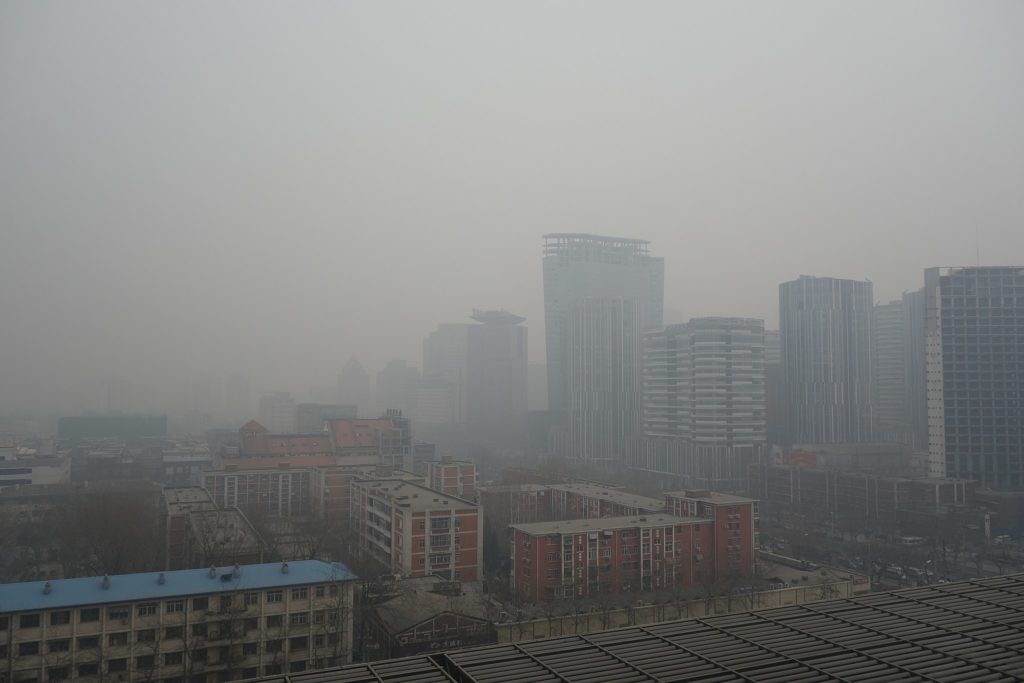Reductions in aerosol emissions had slight warming impact, new research shows
2 February 2021

Air pollution over Beijing, China in February 2014. A new study finds the COVID-19 pandemic affected emissions of pollutants in ways that slightly warmed the planet for several months last year.
Credit: Kentaro Iemoto, CC-2.0
AGU press contact:
Lauren Lipuma, +1 (202) 777-7396, [email protected] (GMT-5)
Contact information for the researchers:
Andrew Gettelman, National Center for Atmospheric Research, [email protected] (GMT-7)
National Center for Atmospheric Research press contact:
David Hosansky, +1 (720) 470-2073, [email protected] (GMT-7)
WASHINGTON—The lockdowns and reduced societal activity related to the COVID-19 pandemic affected emissions of pollutants in ways that slightly warmed the planet for several months last year, new research finds.
The new study in Geophysical Research Letters, which publishes high-impact, short-format reports with immediate implications spanning all Earth and space sciences, highlights the influence of airborne particles, or aerosols, that block incoming sunlight. When emissions of aerosols dropped in the spring of 2020, more of the Sun’s warmth reached the planet, especially in heavily industrialized nations like the United States and Russia that normally pump high amounts of aerosols into the atmosphere.
“There was a big decline in emissions from the most polluting industries, and that had immediate, short-term effects on temperatures,” said Andrew Gettelman, a senior scientist at the National Center for Atmospheric Research and lead author of the new study. “Pollution cools the planet, so it makes sense that pollution reductions would warm the planet.”
Temperatures over parts of Earth’s land surface last spring were about 0.1-0.3 degrees Celsius (0.2-0.5 degrees Fahrenheit) warmer than would have been expected with prevailing weather conditions, the study found. The effect was most pronounced in regions normally associated with substantial emissions of aerosols, with the warming reaching about 0.37 degrees Celsius (0.7 degrees Fahrenheit) over much of the United States and Russia.
The new study highlights the complex and often conflicting influences of different types of emissions from power plants, motor vehicles, industrial facilities, and other sources. While aerosols tend to brighten clouds and reflect heat from the Sun back into space, carbon dioxide and other greenhouse gases have the opposite effect, trapping heat near the planet’s surface and elevating temperatures.
Gettelman emphasized that the long-term impact of the pandemic may be to slightly slow climate change because of reduced emissions of carbon dioxide, which lingers in the atmosphere for decades and has a more gradual influence on climate. In contrast, aerosols have a more immediate impact that fades away within a few years.
Teasing out the impacts
Although scientists have long been able to quantify the warming impacts of carbon dioxide, the climatic influence of various types of aerosols, including sulfates, nitrates, black carbon, and dust, has been more difficult to pin down. One of the major challenges for projecting the extent of future climate change is estimating the extent to which society will continue to emit aerosols in the future, and the influence of the different types of aerosols on clouds and temperature.
In the new study, Gettelman and his colleagues used two of the world’s leading climate models: the NCAR-based Community Earth System Model and a model known as ECHAM-HAMMOZ, which was developed by a consortium of European nations. They ran simulations on both models, adjusting emissions of aerosols and incorporating actual meteorological conditions in 2020 such as winds.
This approach enabled them to identify the impact of reduced emissions on temperature changes that were too small to tease out in actual observations, where they could be obscured by the variability in atmospheric conditions.
The results show the warming effect was strongest in the mid and upper latitudes of the Northern Hemisphere. The effect was mixed in the tropics and comparatively minor in much of the Southern Hemisphere, where aerosol emissions are not as pervasive.
Gettelman said the study will help scientists better understand the influence of various types of aerosols in different atmospheric conditions, helping to inform efforts to minimize climate change. Although the research illustrates how aerosols counter the warming influence of greenhouse gases, he emphasized that emitting more of them into the lower atmosphere is not a viable strategy for slowing climate change.
“Aerosol emissions have major health ramifications,” he said. “Saying we should pollute is not practical.”
###
AGU (www.agu.org) supports 130,000 enthusiasts to experts worldwide in Earth and space sciences. Through broad and inclusive partnerships, we advance discovery and solution science that accelerate knowledge and create solutions that are ethical, unbiased and respectful of communities and their values. Our programs include serving as a scholarly publisher, convening virtual and in-person events and providing career support. We live our values in everything we do, such as our net zero energy renovated building in Washington, D.C. and our Ethics and Equity Center, which fosters a diverse and inclusive geoscience community to ensure responsible conduct.
Notes for Journalists
This research study is open access. Download a PDF copy of the paper here. Neither the paper nor this press release is under embargo.
Paper title:
“Climate Impacts of COVID-19 Induced Emission Changes”
Authors:
A. Gettelman: National Center for Atmospheric Research, Boulder, Colorado, United States; Atmospheric, Oceanic and Planetary Physics, Oxford University, Oxford, United Kingdom;
R. Lamboll: Imperial College, London, United Kingdom;
C. G. Bardeen: National Center for Atmospheric Research, Boulder, Colorado, United States;
P. M. Forster: Priestly Centre, University of Leeds, Leeds, United Kingdom;
D. Watson-Parris: Atmospheric, Oceanic and Planetary Physics, Oxford University, Oxford, United Kingdom.